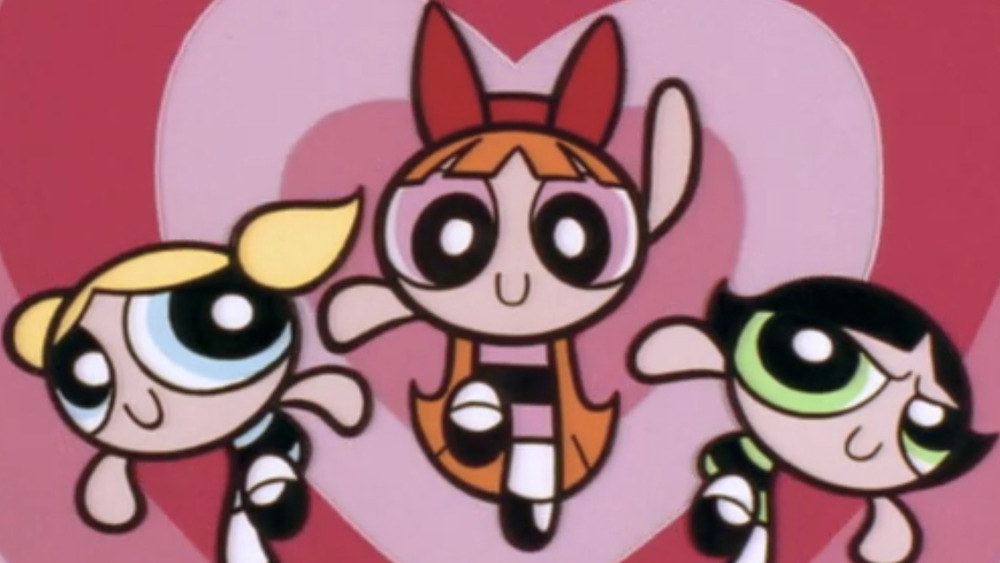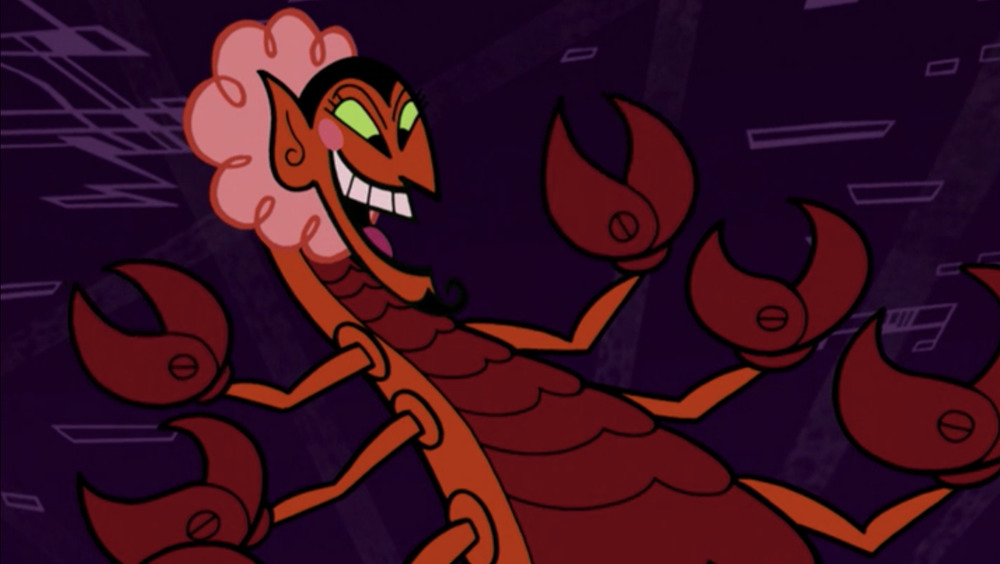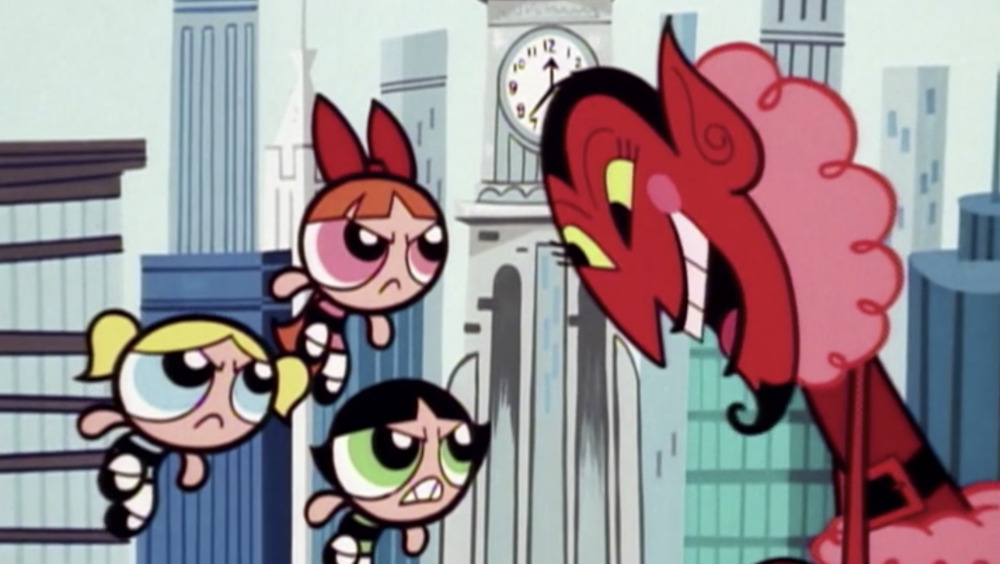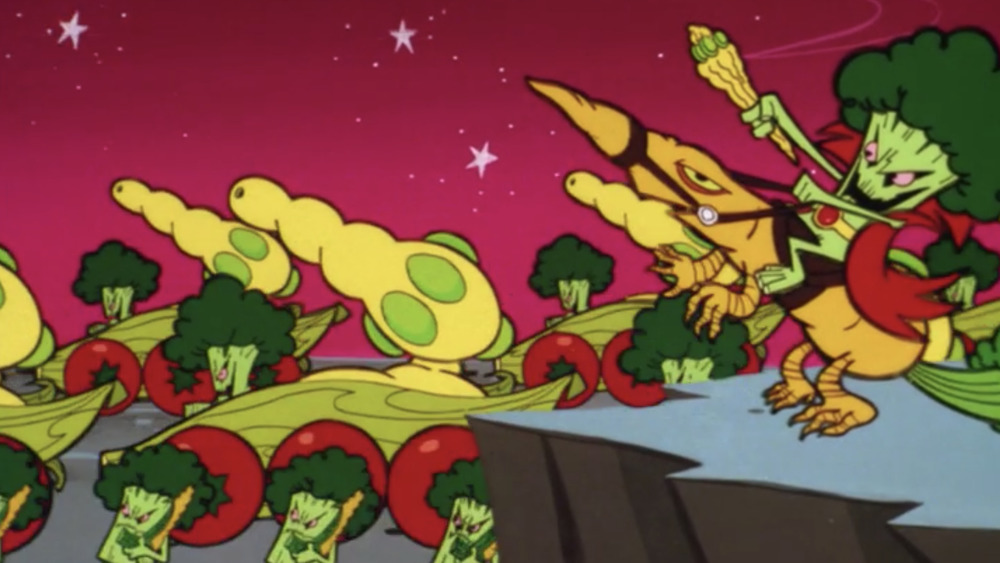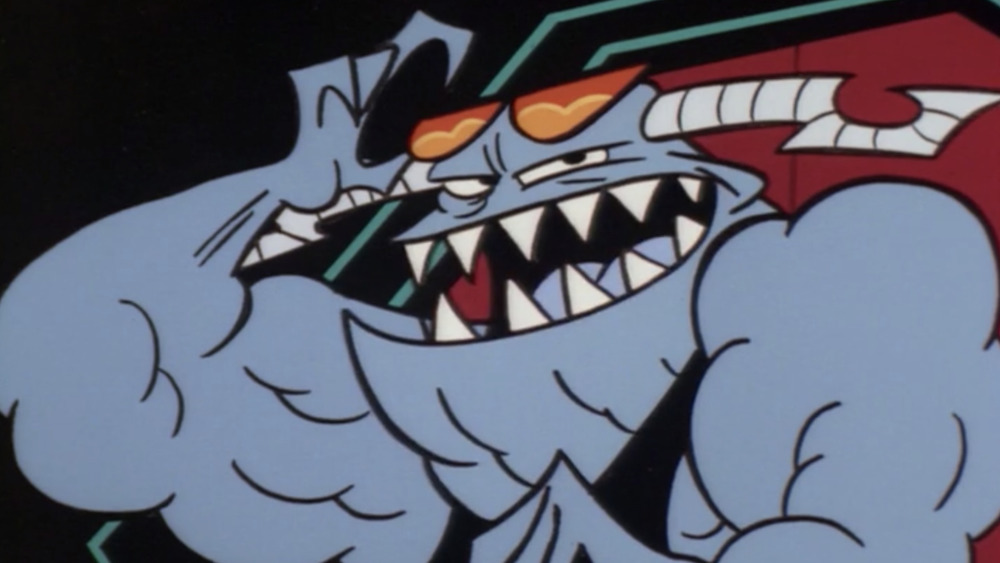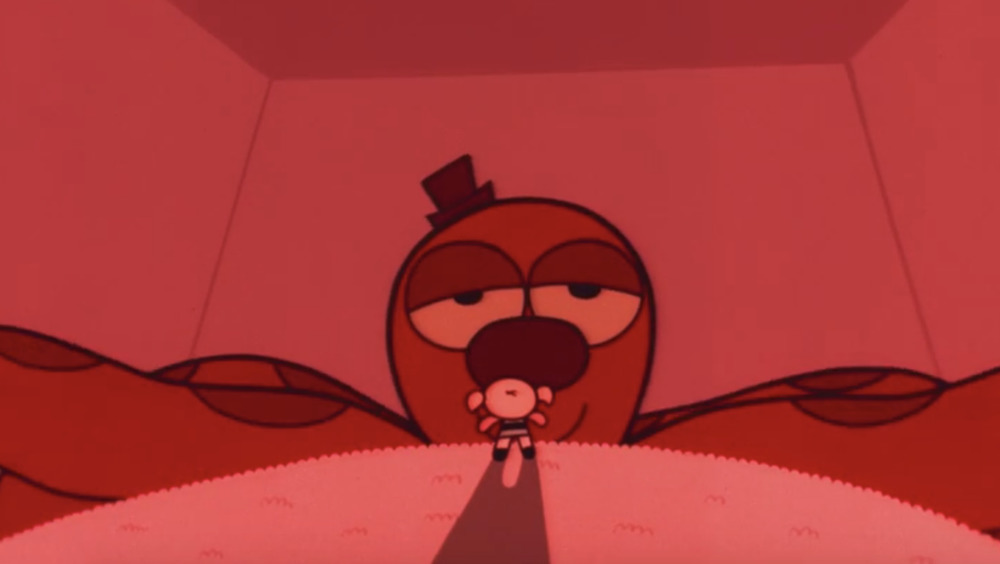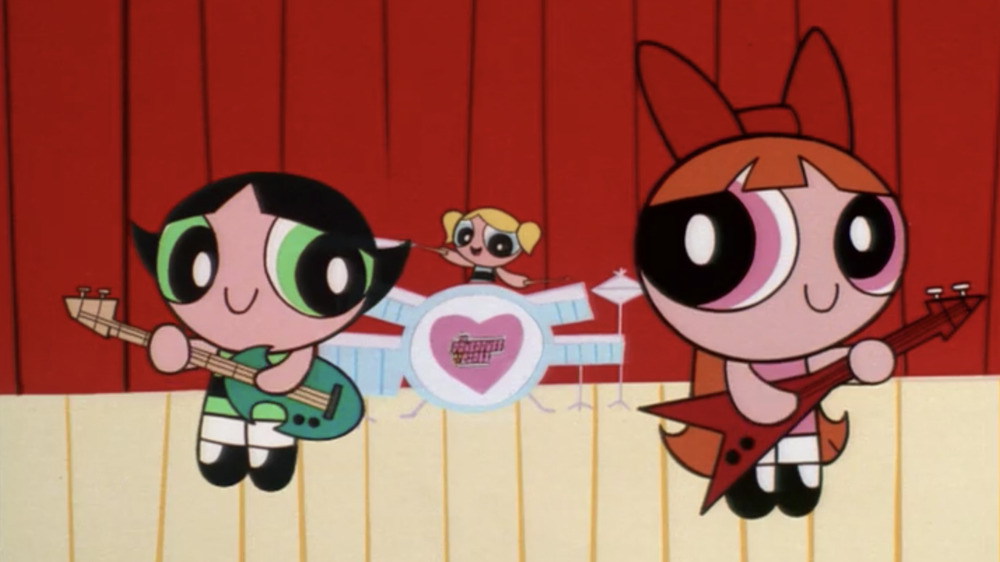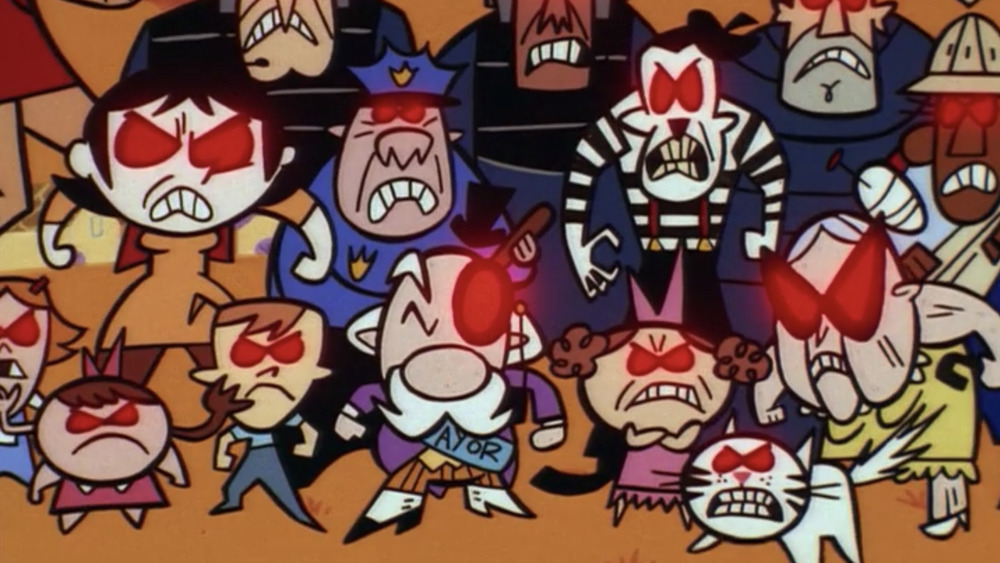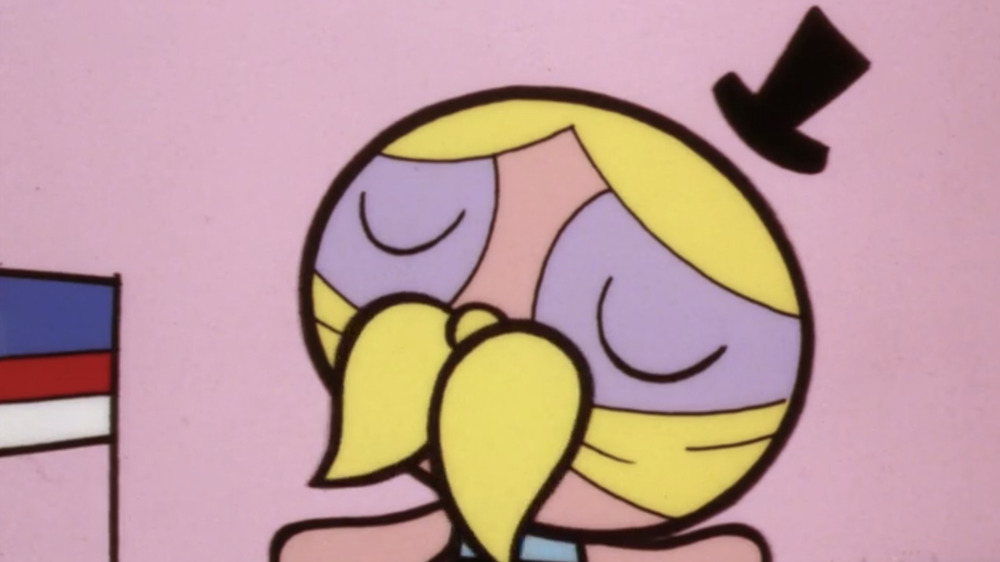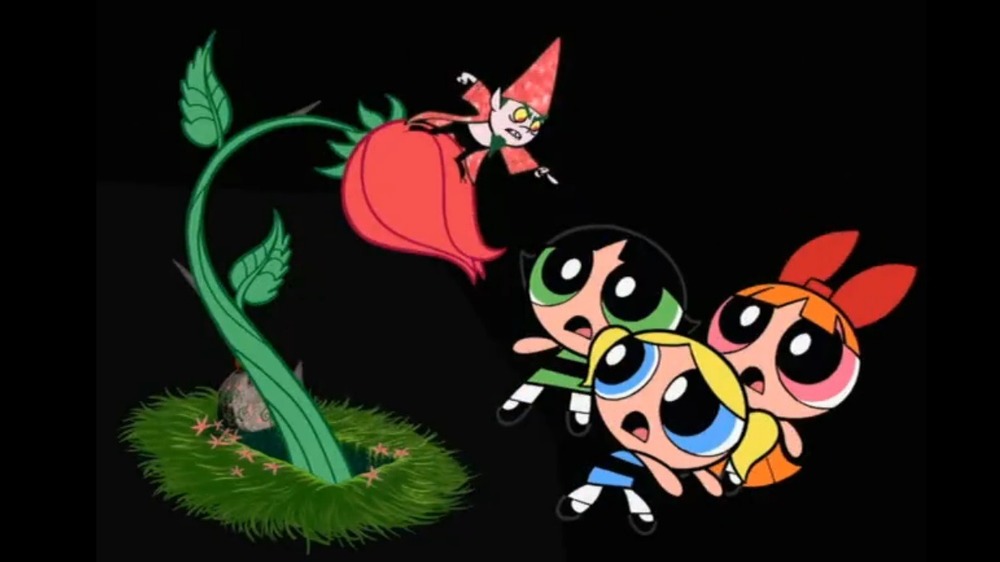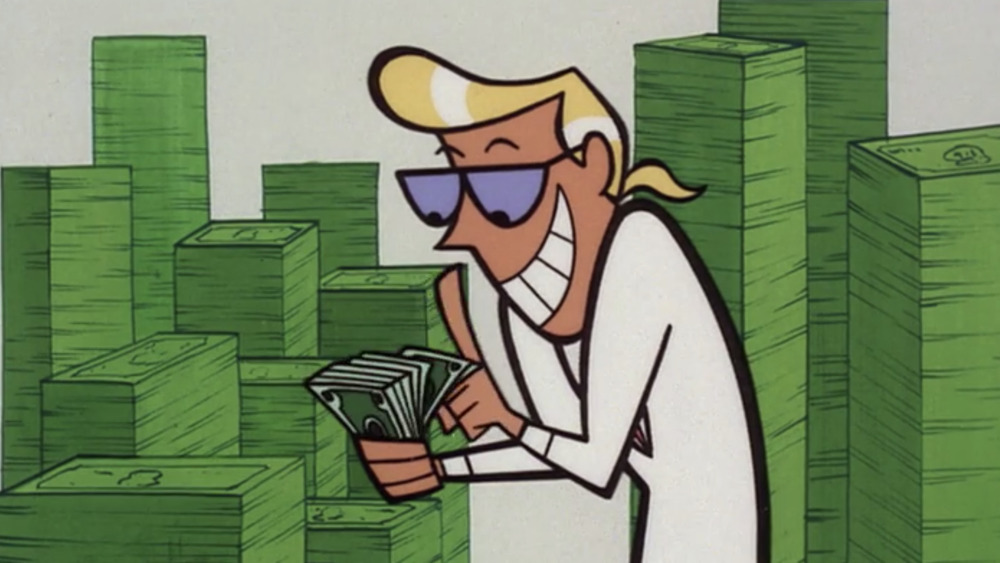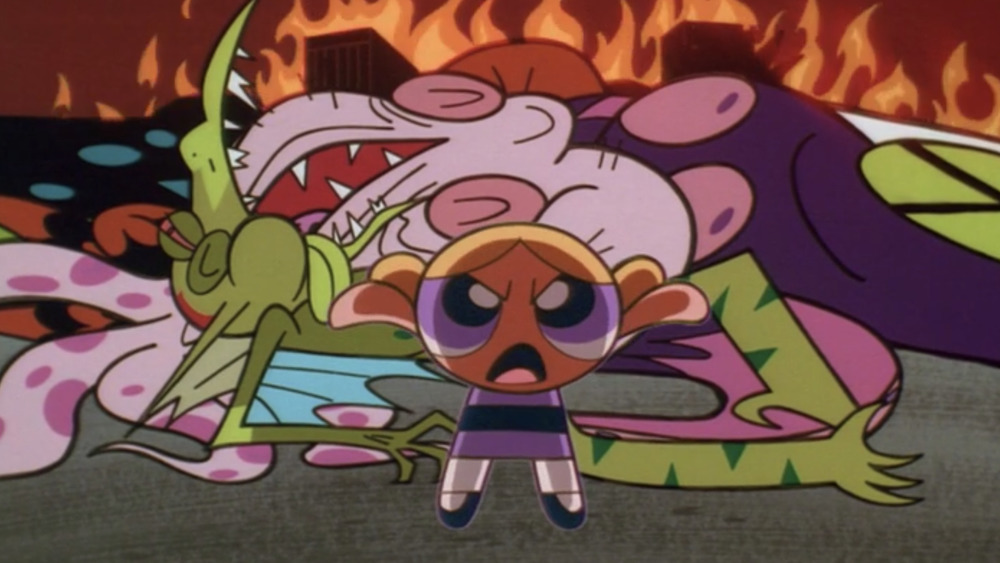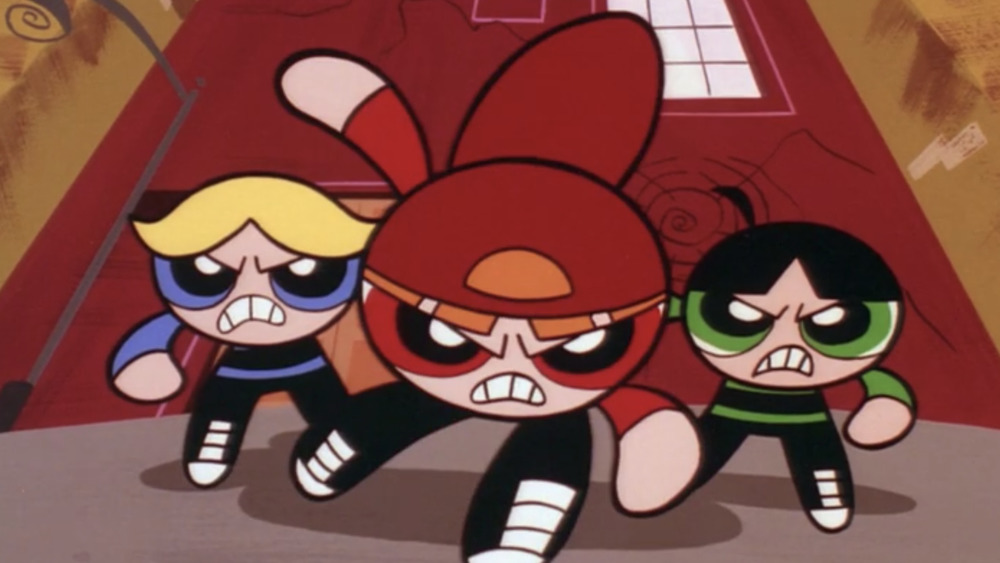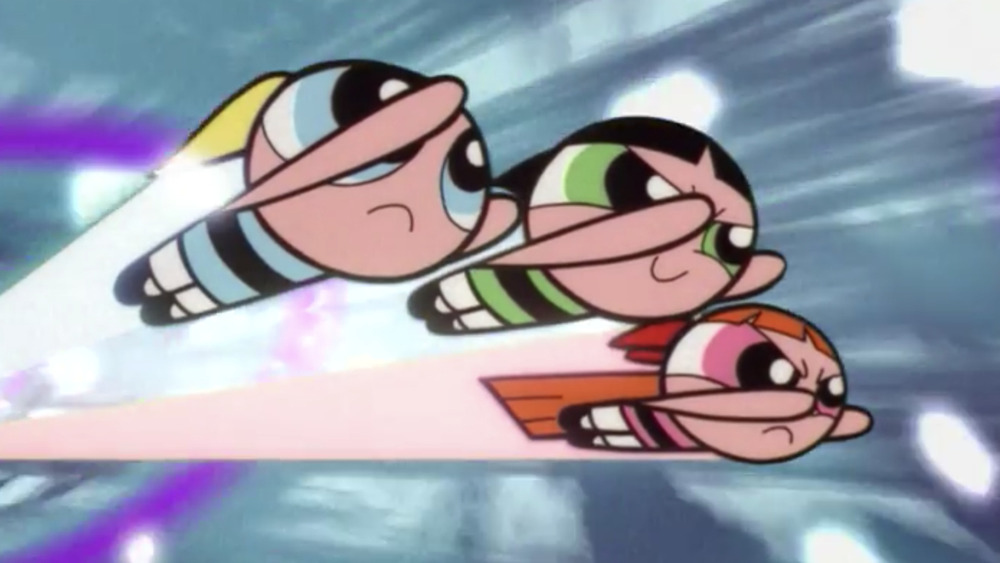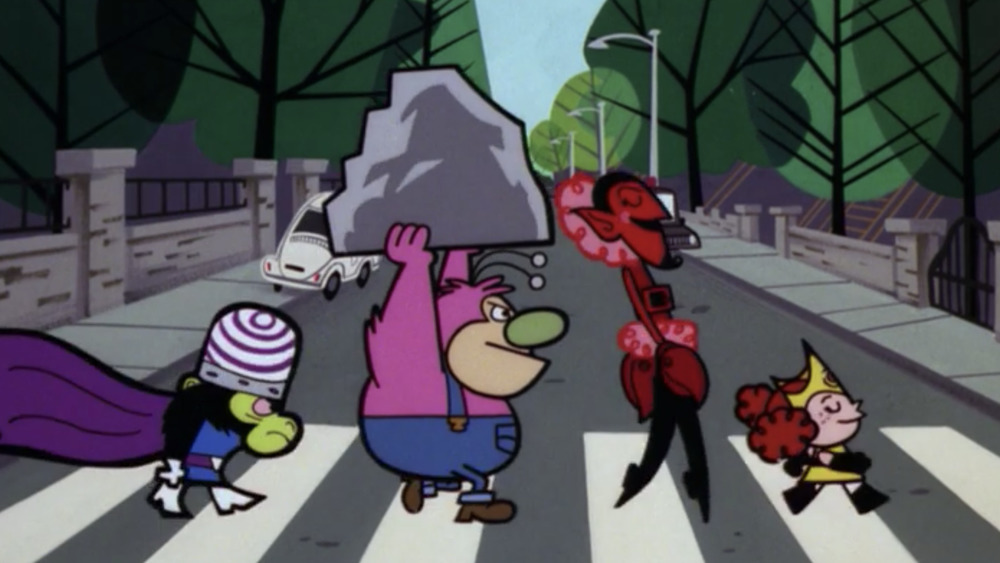The Best Powerpuff Girls Episodes According To IMDb
A playfully absurd sense of humor, distinct character design, and surprisingly grotesque violence — these were the ingredients chosen to create the perfect animated superhero comedy. But creator Craig McCracken added an extra ingredient to the concoction, peppering in jokes and references aimed for grown-up viewers, which helped The Powerpuff Girls transcend Cartoon Network's young viewership and become a broader pop culture phenomenon. Blossom (voice of Catherine Cavadini), Bubbles (Tara Strong), and Buttercup (E.G. Daily) are household names who have starred not only in the celebrated 78-episode run of the original Powerpuff Girls series, but a feature film, along with American and Japanese remakes.
Now, with the pilot for a live-action spinoff in the works, we decided to poke through IMDb to see which episodes fans have singled out as the series' best. There are too many tie scores to create a definitive Top 10, so we've included every episode with an average rating of 7.7 or higher in ascending order.
Power-Noia (Season 4, Episode 12)
When scanning through IMDb's most highly-ranked Powerpuff Girls episodes, an interesting trend begins to emerge. While only making a full appearance in 15 segments, the devilish villain known only as HIM (Tom Kane) features in more entries on this list than any other of the show's antagonists. This may be due to HIM being an outlier in the Powerpuff rogues' gallery — where most of their enemies are bumbling, self-defeating idiots, HIM is an nigh-omnipotent being who represents a genuine threat and therefore raises the stakes of most episodes in which he appears.
In this full-length episode, HIM goes Nightmare on Elm Street on the Powerpuff Girls and tortures them in their dreams using manifestations of their greatest fears. In their sleep, Blossom is unable to answer the simplest questions in school, Buttercup is menaced by an army of giant spiders, and Bubbles' stuffed animals transform into vicious predators. But while the girls' fears may be overpowering, they pale in comparison to the strength of their sisterly bond and their belief in each other.
Him Diddle Riddle (Season 4, Episode 4)
In "Him Diddle Riddle," HIM forces the Powerpuff Girls to participate in a marathon of puzzles and riddles, or else "Professor Utonium is going to pay." Pay what, and how, exactly? We don't know — the story begins in medias res, as the girls struggle to complete challenge after challenge in the hope of saving their beloved father. As a result, the episode amounts to a series of gags that, since the girls only have about two minutes to solve each one, can't overstay their welcome. "Him Diddle Riddle" keeps up a breakneck pace throughout, to the extent that the ambiguity of the stakes can be easily forgotten right up until the point that they can't be avoided any longer. Since this is The Powerpuff Girls, a viewer should know to expect the unexpected, but in this case, the final swerve is even more off-the-wall than usual.
Beat Your Greens/Down 'n Dirty (Season 2, Episode 4)
"Beat Your Greens" is a twist on the classic alien invasion narrative, in which the city of Townsville is invaded by the evil alien Broccoloids. (If you guessed that these aliens are four feet tall and walking, talking stalks of broccoli, you guessed correctly.) The Broccoloids corrupt the city's supply of broccoli with brainwashing spores, which paralyzes the entire adult population but leaves the fussy, vegetable-hating children of Townsville unaffected. The PPGs must rally the kids into an army to beat the invaders the only way they can — by eating them alive! In a typical demonstration of The Powerpuff Girls' penchant for putting a sick twist on a wholesome message, the children of Townsville learn the importance of a balanced diet by taking full bites out of terrified sentient beings.
"Down 'n Dirty" is less memorable, dealing with Buttercup's refusal to take a bath even after being doused in the revolting fluids of multiple disgusting giant monsters. If nothing else, "Down 'n Dirty" is a reminder that, on the scale of 1990s kids cartoons, The Powerpuff Girls could be pretty gross.
Boogie Frights/Abracadaver (Season 1, Episode 6)
In "Boogie Frights," the Boogie Man is real and he's gettin down to some '70s grooves! When the leisure-suited Boogie Man blocks out the sun with a giant disco ball, monsters crawl out from under beds all across town to party loud and menace humanity. This chapter sports a memorable guest performance from Kevin Michael Richardson as the Boogie Man, an array of unique monster designs, and a sudden but comical hard left turn into Star Wars pastiche.
In the episode's other segment, "Abracadaver," a long-dead stage magician is accidentally resurrected as a zombie who takes revenge on the town that mocked him. Being paired with "Boogie Frights" hurts this segment a bit, since it also relies on a montage of imaginative mayhem that simply isn't as fun as the one that came before it. And while "Boogie Frights" also has a sudden third-act twist, "Abracadaver's" ending truly comes out of nowhere and dissolves what little tension exists in a cute children's cartoon.
Octi Evil/Geshundfight (Season 1, Episode 3)
The earliest entry on the list is "Octi Evil," the debut episodic appearance of HIM. After his latest giant monster fails to defeat the Powerpuff Girls, HIM spies a potential weakness: the rivalry between Blossom and Buttercup, and how much it upsets Bubbles when they fight. HIM possesses Bubbles' beloved stuffed animal Octi, exploiting her naivety and using this guise to sow discord between the girls. It's an early exploration of the relationship between the sisters, and the first obvious instance of the show's creators really trying to freak out young viewers.
On the flipside is "Geshundfight," which introduces the Amoeba Boys, Townsville's lamest criminals (and there's a lot of competition). The Amoebas are desperate to prove their badness, botching produce stand heists and failing to impress the PPGs with their willingness to litter. But their next big scheme — loitering next to a "keep off the grass" sign — breeds an actual menace when it transforms them from harmless giant single-celled idiots into a genuine plague that brings the city to a halt. Like the Amoeba Boys themselves, it's a charming but forgettable segment, but the charm of "Octi Evil" pulls the extra weight to earn this episode its spot among the top ranking episodes.
Just Another Manic Mojo/Mime for a Change (Season 1, Episode 11)
"Just Another Manic Mojo" is a "villain episode" depicting a day in the life of the evil genius chimpanzee Mojo Jojo (Roger L. Jackson), with all the mundane details intact. The entire first half is deliberately slow and plodding — Mojo wants to make breakfast but discovers he doesn't have enough eggs, he goes out to buy groceries and realizes he's forgotten his wallet, etc. Every minor frustration is treated with the same gravity as a giant monster tromping through town. Finally, something resembling drama unfolds as the PPGs accidentally hit a baseball through his window and he tries to leverage the opportunity to destroy them. Seeing the world as Mojo does — as a constant nuisance — it becomes impossible not to feel bad for the guy even as you laugh at his pain and misfortune.
In "Mime for a Change," Rainbow the Colorful Clown (Tom Kenny) gets splashed with bleach and becomes the joyless Mr. Mime, gaining the ability to drain the life and color from individuals and entire city blocks. In the shorthand of the episode, losing color also means silence, so it's only appropriate that the solution should come in the form of music. The episode's climax is the original pop-rock song "Love Makes the World Go Round," an adorable fan-favorite moment.
Telephonies/Tough Love (Season 1, Episode 6)
In "Telephonies," teenage ruffians the Gangreen Gang get bored of garden-variety prank calling and decide to step up their game. The gang takes over the Mayor's office and they begin using his direct line to the Powerpuff Girls to call in fake emergencies. (Grubber, as it turns out, can perfectly imitate any voice.) They sic the PPGs on Mojo Jojo, Fuzzy Lumpkins (Jim Cummings), and HIM — who, for a change, aren't planning any crimes today. The Powerpuff Girls isn't the first cartoon to occasionally treat supervillains like regular working stiffs with unusual jobs, but for most young viewers, it would likely be the first, and it's played here to good comic effect.
We suspect, however, that "Tough Love" is the standout that earned the high IMDb average. It's another "HIM uses magic to torture the Powerpuffs" episode in which the devilish villain transmutes the town's love for the girls into pure hate. Everyone is suddenly ticked off at them, from random townsfolk all the way to the Narrator. In addition to delivering on a concept that's gut-level terrifying for any child (and some adults) watching, it also ends on a classic Powerpuff Girls moral subversion that, this early in the show's run, was totally unexpected.
The Powerpuff Girls' Best Rainy Day Adventure Ever/Just Desserts (Season 2, Episode 10)
Kicking off the episode is "The Powerpuff Girls' Best Rainy Day Adventure Ever," one of the cutest installments in the show's entire run. With the city basically shut down due to inclement weather, the Powerpuffs have no crime to fight. Instead, they do the same thing that any kids their age would do on a rainy day indoors — they play make-believe. Specifically, they pretend that they're the Powerpuff Girls saving the day from villains and monsters. They swap roles, imitate each other and the rest of the cast and essentially stage a delightful, spot-on parody of their own lives.
After "Best Rainy Day..." is "Just Desserts," a sequel to an earlier episode, "Supper Villain," in which the Powerpuffs' neighbor Harold Smith tries his hand at costumed villainy and suffers a humiliating defeat in front of his family. In "Just Desserts," Harold is released from prison and discovers that his wife and children have been preparing for his return by creating their own supervillain identities, and are ready to embark on a mission of revenge against the Powerpuffs. "Just Desserts" is a terrific example of the show's affinity for blending comic book bombast with the banality of everyday life, beating The Incredibles to a handful of gags by four years.
See Me, Feel Me, Gnomey (Season 5, Episode 7)
A show that likes to play with genre as much as The Powerpuff Girls was always eventually going to do a musical episode. "See Me, Feel Me, Gnomey" is a sung-through rock opera composed by storyboard artist & writer David Smith in which, after suffering a crushing defeat at the hands of their combined rogues' gallery, the Powerpuffs relinquish their powers to an opportunistic gnome. The nameless gnome (Jess "Wakko Warner" Harnell) banishes the villains, but turns the entire city into a submissive cult centered around himself.
"See Me, Feel Me, Gnomey" is a novelty, which helps to account for its high IMDb score. The music is polished, energetic, and textured in the vein of '70s psych or '80s stadium rock, though the lyrics feel like the work of an amateur songwriter. It also channels some of its hippie influences visually, which may have gotten the show's producers in some hot water — this is the only episode of The Powerpuff Girls that has never aired in the United States, and it's also missing from HBO Max. According to show creator Craig McCracken on his personal Tumblr, Cartoon Network objected to some of the imagery, such as one of the townspeople looking too much like Jesus Christ, and the city's broken skyscrapers looking like crosses. McCracken claims this was entirely unintentional and that the team was surprised that the censors blocked the broadcast.
We don't see it, either, Craig.
Knock it Off (Season 4, Episode 6)
In this full-length episode, Professor Utonium's screwup creep roommate Dick Hardly (Jeff Bennett) comes to town looking to steal some ideas, but is dazzled by Utonium's greatest scientific achievement — the Powerpuff Girls. Dick wants to try and monetize the PPGs, so he tricks the formula and some Chemical X out of the girls and mass-produces his own downmarket knockoffs — The Powerpuff Girls Xtreme — to sell as a consumer product. The higher demand gets, the faster his factory cranks them out, and the worse the knockoffs get, all while making Dick a fortune.
Naturally, it ends with Dick turning himself into a real monster for the girls to fight, but up until his mutation, Dick Hardly is the rare Powerpuff Girls villain who doesn't have a broad gimmick or an idiosyncratic weakness — he's just a nasty opportunist trying to get rich at any cost, which makes him the most realistic bad guy on the show.
Bubblevicious / The Bare Facts (Season 1, Episode 9)
"Bubblevicious" showed the audience just how far Craig McCracken and company were willing to go with The Powerpuff Girls' over-the-top blood 'n' guts. Tired of being underestimated, Bubbles locks herself in the holographic simulator and turns the difficulty all the way up until she emerges as a "hardcore" fighter who's more than a match for Mojo Jojo on her own. During her time in the knockoff Danger Room, Bubbles fights a slew of giant monsters whose green and orange blood and bile are spilt liberally. There are still laughs to be found in the juxtaposition of the visceral carnage against the silly Cartoon Network art style, but when "Bubblevicious" aired in 1999, the very idea of a kids' cartoon showing a monster getting impaled with its own tusk was funny in and of itself.
In "The Bare Facts," the Powerpuffs try to explain to Townsville's bumbling Mayor (Tom Kenny) what happened to him while he was kidnapped and blindfolded by Mojo Jojo. The narrative jumps between the Mayor's first-person perspective and the three girls' recollections, all leading to a totally telegraphed but still funny closing reveal. The episode features four separate art styles — the "real" world, plus each of the Girls' stylized points of view, which makes this one of the most memorable and visually striking episodes of the first season.
The Rowdyruff Boys (Season 1, Episode 12)
Every superhero needs evil doppelgängers. Tired of being defeated over and over and over, Mojo Jojo concocts a new scheme to destroy the Powerpuff Girls — by creating his own superpowered trio. Made of snips (armchair clippings from a prison inmate), snails (from the kitchen), and a puppy dog tail ripped from Talking Dog, plus the contents of his toilet in place of Chemical X, Brick, Boomer, and Butch — The Rowdyruff Boys — are born and looking for butts to kick. Mojo needs only to point them in the direction of the only worthy competition in town and sit back and enjoy the showdown.
Once the two sets of superpowered kids meet, the episode plays the conflict just about straight with relatively few gags, just some imaginative action and city-scale stakes. In a page out of Superman II, the Boys' biggest advantage is their willingness to endanger innocent lives, forcing the Girls to play defense and prevent collateral damage. The ultimate resolution to the conflict may not be the most progressive — the girls each give their counterpart a kiss on the cheek, causing the Rowdyruffs to self-destruct from cootie poisoning — but as an extrapolation of "kid logic" into the physical world of the show, it's a solid bit.
Speed Demon/Mojo Jonesin' (Season 2, Episode 12)
We'll be honest — we have no idea what this episode is doing tied for the top spot on IMDb's episode rankings.
"Speed Demon" stands out for being one of the darkest episodes of the series, as the Powerpuff Girls accidentally propel themselves 50 years in the future and arrive in a Townsville that is now an apocalyptic hellscape. The girls travel across the city, encountering the withered, traumatized revenants of Professor Utonium, Miss Keane, and Ms. Bellum, before finally learning that, in their absence, HIM has conquered the Earth. It's spookier than your average episode, but after the three-minute mark, it more or less forgets that The Powerpuff Girls is a comedy.
"Mojo Jonesin'" is an offbeat chapter, as well, focusing on four of the girls' classmates as they become accidentally addicted to temporary superpower boosts provided by a thinly disguised Mojo Jojo. "Mojo Jonesin'" is both an example and a parody of "say no to drugs" narratives, but much of the humor is dated and the action isn't exceptional by Powerpuff Girls standards. Nevertheless, the people have spoken, and with an average score of 8.6/10, "Speed Demon"/"Mojo Jonesin" shares the top spot whether we like it or not.
Moral Decay/Meet the Beat-Alls (Season 3, Episode 13)
The first half of the other top-scoring episode, "Moral Decay," is a run-of-the-mill misadventure in which Buttercup becomes immediately addicted to the power of money and starts knocking out villains' teeth to trade to the tooth fairy for cash. It's fun, short, and ultimately, not why we're here.
The real star of the show is "Meet the Beat-Alls," which — excepting any kids who happened to watch The Beatles Anthology documentary on TV four years earlier — is one for the grown-ups. After years of humiliation as solo acts, Mojo Jojo, HIM, Princess Morebucks (Jennifer Hale), and Fuzzy Lumpkins team up and handily defeat the Powerpuff Girls. They form a partnership, dubbing themselves "The Beat-Alls," and for the next 10 solid minutes, nearly every single line or shot is a reference to 1960s rockers the Beatles. The plot mirrors the mythology of the Beatles' breakup (complete with a Yoko Ono analog), much of the dialogue is comprised of song lyrics, and there are sight gags both overt (a cameo by Sgt. Pepper) and subtle (the Beat-Alls' final crime spree takes place on a rooftop).
While certainly scoring bonus points for novelty, "Meet the Beat-Alls" is also one of the most playful, joke-dense episodes of the series, and a demonstration of the sharp wit that made The Powerpuff Girls such a sensation in its day. It's a reminder that kids' cartoons are made by adults, letting older viewers feel a bit less embarrassed for watching.
